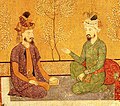Qaba


A qaba (Persian: قبا, romanized: qabā, from Middle Persian kabāh) is a long coat with sleeves and buttons, similar to a cassock, open at the front. A qaba is similar to a wadded coat. It is considered of Turkic origin.[4]
The Mughal emperors wore ankle-length garments. The outfits during the reign of Babur and Humayun are more or less the same, i.e. qaba, jama, pirahan, jilucha, jiba and kasaba. Unlike the jama, which was a four-pointed long-coat the Qaba and takauchia were of a broad girth at the bottom. There are mentions of the qaba in the Baburnama. At present, qaba is one of the essential parts of the dress of the clerics or mosque leaders.[5][6][7][8][9][10][11][12] It was worn in Egypt, Turkey, the Levant, and Persia, among other places.[13]
When Henry II, Count of Champagne, king of Jerusalem, tried to build a friendly relationship with Saladin, he requested the gift of a qabā and a sharbūsh', which he wore in Acre.[14][15]
In Arab contexts, two main variations were noted; the Turkish style (al-aqbiya al-turkiyya), and the Tatar (or Mongolian) style (al-aqbiya al-tatariyya or qabā' tatarī). The latter fastened on the wearer's right side, and was preferred by Mamluk amirs in its day over the former style, which was favored by the Seljuks and Ayyubids.[16] Also notable is a variation, typically with a v shaped neck, that closed center front.[17] The garment typically had awaist seamm and some depictions indicate a gathered skirt. It was fastened with buttons or strings tied in bows, and most commonly worn with a belt over top.[16]
See also
[edit]Gallery
[edit]-
Royal drinking scene in the Dukhang at Alchi Monastery, circa 1200 CE. The king wears a decorated Qabā'.[18]
-
Babur and his heir Humayun
-
Late 17th century portrait of Fírúz Jang Khán, ruler of Bijapur
-
Late 19th century "Costume of India - Moguls" picture depicting Mogul woman (upper left), Mogul Emperor Farrukhsiyar (center) died 1719, and Emperor Humayun (upper right), died in 1556
-
Vizier Qamar ud-Din circa 1735
-
Portrait of "Mogul" father with his children in Delhi (Shepherd & Robertson) circa 1863
-
Page from the manuscript of Nihayat al-Sawl; Egypt, Mamluk era, 15th cent.; Museum of Islamic Art, Cairo.
-
Polo players painted onto glass with enamel and gold paint Egypt or Syria about 1300.
-
Enameled and Gilded Bottle.
-
Enameled and Gilded Bottle.
References
[edit]- ^ Flood, Finbarr Barry (2017). A Turk in the Dukhang? Comparative Perspectives on Elite Dress in Medieval Ladakh and the Caucasus. Austrian Academy of Science Press. p. 231.
- ^ Keresztély, Kata (14 December 2018). Fiction Painting : a Medieval Arabic Tradition. p. 351.
- ^ The Glory of Byzantium: Art and Culture of the Middle Byzantine Era, A.D. 843-1261. Metropolitan Museum of Art. 1997. pp. 428–429. ISBN 978-0-87099-777-8.
- ^ Flood, Finbarr Barry (2017). A Turk in the Dukhang? Comparative Perspectives on Elite Dress in Medieval Ladakh and the Caucasus. Austrian Academy of Science Press. p. 231.
- ^ Balslev, Sivan (2019-03-21). Iranian Masculinities: Gender and Sexuality in Late Qajar and Early Pahlavi Iran. Cambridge University Press. p. 208. ISBN 978-1-108-47063-6.
- ^ Johnson, Francis (1852). A Dictionary, Persian, Arabic, and English. Allen. p. 254.
- ^ Islamic Thought and Scientific Creativity: A Quarterly Journal of the COMSTECH. COMSTECH. 1992. p. 66.
- ^ Lal, Kishori Saran, 1920- (1988). The Mughal harem. New Delhi: Aditya Prakashan. ISBN 81-85179-03-4. OCLC 18431844.
{{cite book}}: CS1 maint: multiple names: authors list (link) CS1 maint: numeric names: authors list (link) - ^ Agre, Jagat Vir Singh (1976). "Social Life as Reflected in the Rajput Painting During the Mughal Period". Proceedings of the Indian History Congress. 37: 569–575. ISSN 2249-1937. JSTOR 44139028.
- ^ "India. The Mughal Empire. Costume and fashion history". World4. 2013-09-09. Retrieved 2021-01-29.
- ^ Namrata Zakaria (2019-11-26). "Who made my clothes?". mumbaimirror.indiatimes.com. Retrieved 2021-01-29.
- ^ "تاریخچه لباس روحانیت". خبرگزاری مهر | اخبار ایران و جهان | Mehr News Agency (in Persian). 2015-07-20. Retrieved 2021-01-29.
- ^ Stillman, Yedida K. (2003). Stillman, Norman A. (ed.). Arab dress: a short history; from the dawn of Islam to modern times. Themes in Islamic studies (Revised 2nd ed.). Leiden: Brill. ISBN 978-90-04-11373-2.
- ^ Gabrieli, Francesco. Arab Historians of the Crusades. University of California Press. p. 242.
When the King of England left for home, Henry sent a messenger to Saladin to conciliate him and win his goodwill. He asked him for the gift of a robe of honor, and said: "You know that to put on the qabā and the sharbūsh is not approved among us, but I would put them on if they came from you, because of the regard I have for you." Saladin sent him sumtuous robes of honour, among them a qaba and a sharbush, and he wore them in Acre.
- ^ Mayer, Leo Ary (1952). Mamluk Costume: A Survey. A. Kundig. pp. 27–28.
Moreover, the wearing of the sharbish and qaba was considered so characeristic for a Saracenic amire that even a Crusader was prepared to don it in order to show some sort of friendship (if not allegiance) to Saladin.
- ^ a b Stillman, Yedida K. (2003). Stillman, Norman A. (ed.). Arab dress: a short history; from the dawn of Islam to modern times. Themes in Islamic studies (Revised 2nd ed.). Leiden: Brill. p. 63. ISBN 978-90-04-11373-2.
- ^ Stillman, Yedida K. (2003). Stillman, Norman A. (ed.). Arab dress: a short history; from the dawn of Islam to modern times. Themes in Islamic studies (Revised 2nd ed.). Leiden: Brill. p. 353. ISBN 978-90-04-11373-2.
- ^ Flood, Finbarr Barry (2017). A Turk in the Dukhang? Comparative Perspectives on Elite Dress in Medieval Ladakh and the Caucasus. Austrian Academy of Science Press. p. 243.

![Royal drinking scene in the Dukhang at Alchi Monastery, circa 1200 CE. The king wears a decorated Qabā'.[18]](http://upload.wikimedia.org/wikipedia/commons/thumb/1/19/Royal_drinking_scene_in_the_Dukhang_at_Alchi_Monastery%2C_circa_1200_CE.jpg/96px-Royal_drinking_scene_in_the_Dukhang_at_Alchi_Monastery%2C_circa_1200_CE.jpg)








